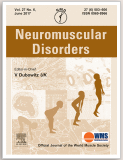 Steinert’s disease (or myotonic dystrophy type 1, or DM1) is one of the most common neuromuscular diseases that affects adults and more rarely children. Due to an expansion of CTG nucleotide triplets in the DMPK gene, this disease is transmitted in an autosomal dominant fashion. Multisystemic by definition, this pathology is at the origin of muscular, cardiac, ophthalmic and endocrine complications. Respiratory complications, which are also very frequent, have a multifactorial origin: respiratory muscle deficit, swallowing disorders and defect in central control play central roles.
Steinert’s disease (or myotonic dystrophy type 1, or DM1) is one of the most common neuromuscular diseases that affects adults and more rarely children. Due to an expansion of CTG nucleotide triplets in the DMPK gene, this disease is transmitted in an autosomal dominant fashion. Multisystemic by definition, this pathology is at the origin of muscular, cardiac, ophthalmic and endocrine complications. Respiratory complications, which are also very frequent, have a multifactorial origin: respiratory muscle deficit, swallowing disorders and defect in central control play central roles.
In an article published in March 2018, clinicians from the neuromuscular reference center near Paris, supported by the AFM-Téléthon, provided an update on the modalities and determinants of this respiratory involvement. From the study of 283 records of adults with DM1 who had consulted for a respiratory evaluation, the authors retraced the natural history of respiratory complications by trying to correlate it with other clinical and genetic parameters. The size of the CTG expansion appears to be predictive of respiratory risk but also of life expectancy. Special attention should be paid to congenital forms of DM1. However, the ability of non-invasive ventilation to alter the natural course of respiratory disease has not been proven. Finally, overweight is an aggravating risk factor and requires specific managment.
